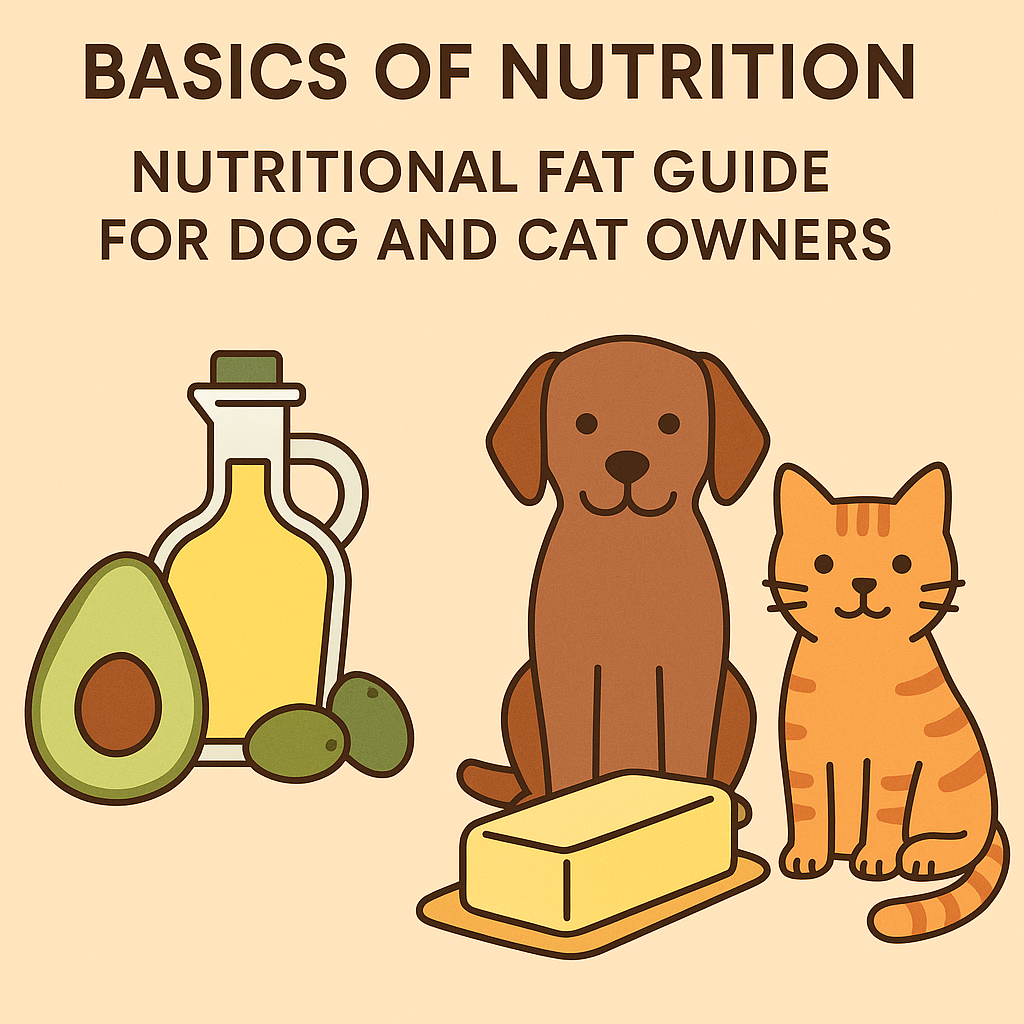
Basics of Nutrition: Nutritional Fat Guide for Dog and Cat Owners
Share
What Are Dietary Fats?
Dietary fats are part of a larger group of compounds called lipids. They are unique because they dissolve in organic solvents but not in water. In pet nutrition, fats are categorized as:
-
Simple lipids – Mainly triglycerides, the most common type of dietary fat, and waxes.
-
Compound lipids – Fats combined with non-lipid molecules, such as lipoproteins, which carry fat in the bloodstream.
-
Derived lipids – Include cholesterol and fat-soluble vitamins.
Among these, triglycerides are the most important in pet diets, influencing energy, health, and food palatability.
Types of Fatty Acids
Fatty acids differ in chain length and saturation:
-
Saturated fatty acids (SFAs): No double bonds, often found in animal fats.
-
Monounsaturated fatty acids (MUFAs): One double bond.
-
Polyunsaturated fatty acids (PUFAs): Two or more double bonds, including essential fatty acids (EFAs).
The configuration of double bonds matters:
-
Cis fatty acids (natural form) are common in plant oils.
-
Trans fatty acids often come from food processing and may negatively affect health.
Medium-Chain Triglycerides (MCTs) in Pet Diets
MCTs, found in coconut oil and butter, contain 8–10 carbon atoms and are easier to absorb. They may help pets with digestive disorders. However, studies in dogs show mixed results—sometimes MCTs behave like regular long-chain fatty acids, and high amounts can reduce food palatability. More research is needed before they are widely recommended in therapeutic diets.
Functions of Fat in the Pet’s Body
Fat isn’t just stored energy—it plays many critical roles:
-
Energy storage: The most concentrated energy source at 9.4 kcal/g, much higher than protein or carbs.
-
Insulation and protection: Cushions organs and prevents heat loss.
-
Cell and nerve health: Lipids form cell membranes and insulate nerve fibers.
-
Metabolic functions: Cholesterol helps form bile salts and hormones.
-
Essential fatty acids (EFAs): Support growth, development, skin health, inflammation control, and more.
Essential Fatty Acids for Dogs and Cats
Pets require two main fatty acid families:
-
n-6 series:
-
Linoleic acid – found in corn, soybean, safflower, and poultry fat.
-
Dogs can make arachidonic acid (AA) from linoleic acid, but cats cannot. Cats need AA directly from animal sources, especially during pregnancy and development.
-
-
n-3 series:
-
Alpha-linolenic acid (ALA) – found in plant oils.
-
Conversion to EPA and DHA is limited, so dietary sources (fish oil, marine oils) may be necessary for optimal development and reproduction.
-
Another special fat, Conjugated Linoleic Acid (CLA), found in ruminant fats, may help manage body composition in overweight pets.
Fat Digestibility and Energy Density in Pet Foods
Fat is highly digestible for pets, with studies showing 70–95% digestibility in dog foods. Because fat is so energy-dense, it significantly increases calorie content. This can be beneficial for active pets but requires portion control to prevent obesity.
Fat and Food Palatability
Fat makes pet food taste better. Studies show that cats, for example, prefer diets with 25–40% fat. However, higher levels can reduce acceptability and may encourage overeating due to higher calorie density. This is why portion-controlled feeding is often necessary with high-fat diets.
Key Takeaways
-
Fat is the most energy-dense nutrient and essential for dogs and cats.
-
It supports energy, growth, reproduction, nerve function, and hormone production.
-
Essential fatty acids (n-6 and n-3 families) must be provided through diet.
-
While fat improves food palatability, too much can cause overeating and weight gain.
-
Cats have unique needs for arachidonic acid that dogs can synthesize.
In conclusion, fat is not just a calorie source—it is vital for your pet’s health, vitality, and wellbeing. The key lies in balance: providing enough fat for essential functions while avoiding excess that may lead to obesity.
